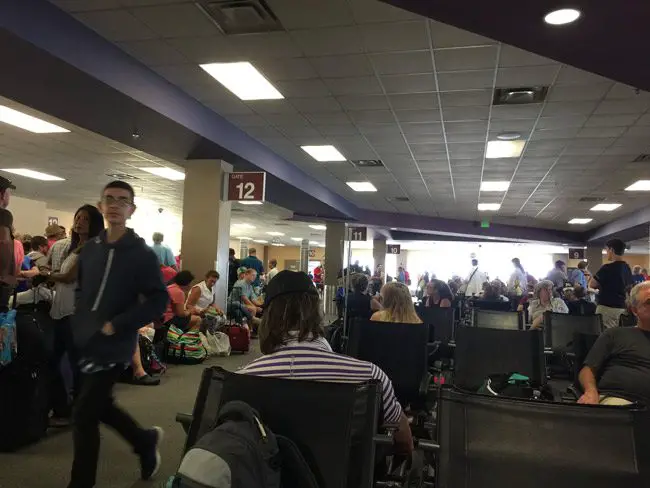
Gov. Rick Scott spent the past week touting the state’s move ahead of Texas in the overall number of passengers boarding airplanes.
While many large commercial airports in Florida have been steadily climbing, the vault to second in the nation in 2016 came with growth predominantly at facilities in Central and South Florida.
“You’d expect to see continued growth in Orlando, because it is a major tourist destination for people all over the world, and continues to be the number one destination for people booking vacations through AAA — based on hotel bookings,” said Mark Jenkins, a AAA spokesman. “St. Pete-Clearwater and Fort Lauderdale airports are popular alternatives to the bigger international airports in Tampa and Miami. People might choose these smaller airports because they are less crowded, so it is easier to get in and out, but also because they can often find cheaper airfares.”
Florida recorded a nearly 4 percent growth in its overall outbound passenger count, from 78.07 million in 2015 to 81.17 million last year, according to annual Federal Aviation Administration data.
The Federal Aviation Administration figures counted 59 active airfields in Florida last year, from the 20.8 million airline passengers departing from Miami International to the single passenger recorded as flying out of Zephyrhills Municipal in Pasco County.
With Florida trailing only California for air passengers, the largest year-to-year increases in such traffic were found at Orlando International, Fort Lauderdale/Hollywood International, Orlando Sanford International and St. Pete-Clearwater International, along with a number of smaller regional facilities, according to the Federal Aviation Administration figures.
Other airports were more in a year-to-year holding pattern.
Miami International went down 0.9 percent from the previous year.
Tampa International, with 9.2 million passengers, was up 0.48 percent from the prior year and Southwest Florida International Airport in Fort Myers, at 4.2 million passengers in 2016, grew 1.86 percent.
West Palm Beach International’s 3.1 million passengers in 2016 represented a 0.51 percent decline.
Jacksonville International’s 2.7 million passengers represented a 0.3 percent drop. And Pensacola International, with 792,916 passengers last year, reported a 0.6 percent increase.
Scott, in part, credited the recent uptick in passengers to state infrastructure spending.
“Florida’s airports help welcome millions of visitors, business leaders and families to our state each year, and have a significant impact on supporting job creation and growing our economy,” Scott said in a prepared statement. “That is why I am proud that we have invested more than $1 billion in state funding in our airports over the past six years.”
The state spending includes $263 million for aviation improvements in the budget that started July 1.
Stephen Lawson, Visit Florida vice president of government relations, credited the state’s tourism marketing — $76 million last fiscal year — in assisting with the aviation growth.
Lawson added that British Airways has announced plans to provide non-stop flights from London to Fort Lauderdale.
“Since the total economic impact of tourism to our state is over $183 billion, a 4 percent increase in airline passengers is a big deal for Florida’s economy,” Lawson wrote in a blog Friday.
Florida’s growth occurred as Texas, with 56 different facilities, saw its passenger count go up 0.2 percent, to 79.87 million.
The next hurdle for Florida remains California, which experienced 7.2 percent growth in traffic that put its outbound passenger count in 2016 at 105.7 million.
California, topped by 39.6 million passengers last year at Los Angeles International and 25.7 million at San Francisco International, had people flying out of 74 different locations.
Among Florida’s top 10 busiest airports, Orlando International grew 8.12 percent year to year, bumping its terminal count to 20.3 million in 2016.
Orlando-Sanford International, an alternative to the massive Orlando International, went up 9.18 percent, to 1.3 million passengers last year.
Fort Lauderdale-Hollywood grew by 9.2 percent, to 14.26 million.
The largest percentage year-to-year increase among the 10 busiest was St. Pete-Clearwater International, going from 819,974 passengers in 2015 to 915,668 in 2016, an 11.67 percent jump, primarily due an expansion of routes by Allegiant Air, the airport’s dominant carrier.
The state’s numbers were also bolstered with 32.6 percent growth at Punta Gorda airport in Charlotte County, an 18 percent increase at Destin-Fort Walton Beach Airport and an 11.7 percent jump at Daytona Beach International.
Among smaller commercial services and general aviation airports that each record fewer than 10,000 passengers a year, 11 facilities in Florida posted more than 100 percent growth, topped by Vero Beach International which is listed by the FAA as having gone from 101 passengers in 2015 to 4,581 in 2016. Naples Municipal went from 110 to 1,335. Miami’s Opa-Locka Executive grew from 212 to 1,246.
–Jim Turner, News Service of Florida




























Leave a Reply